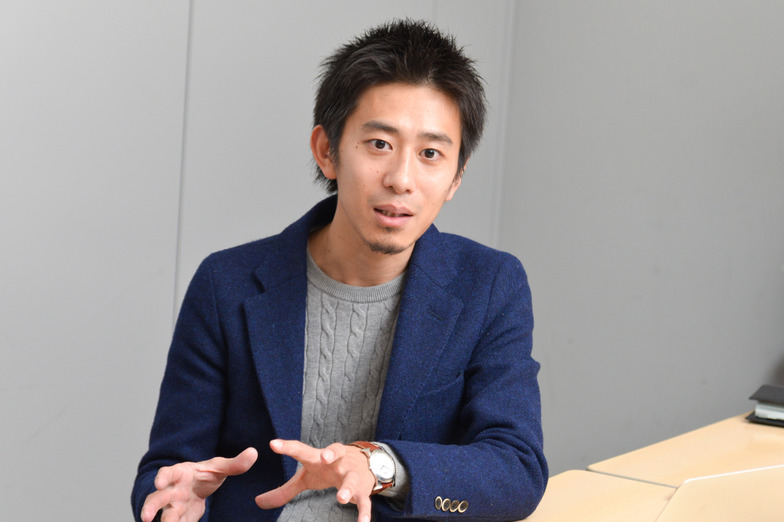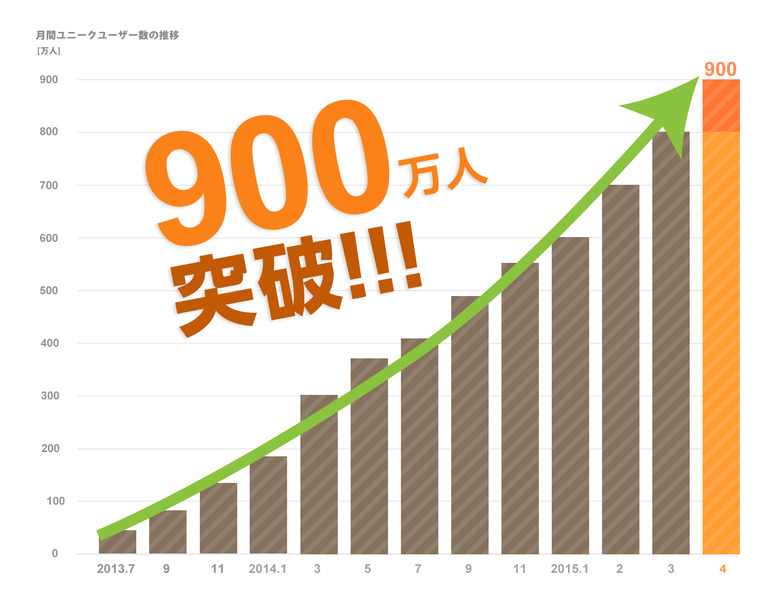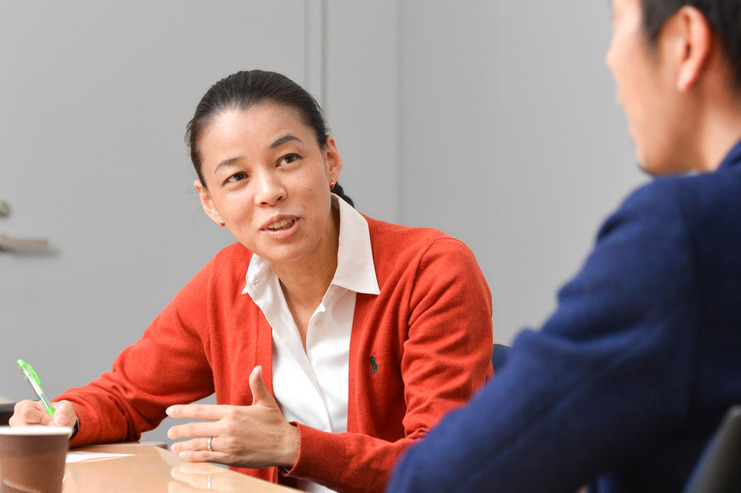For the third installment of our "From the Front Lines of Content Marketing" series, we shift perspective slightly to explore how to engage everyday consumers in content creation. We spoke with Kazuya Takeda, President of Retty, about the core of this approach. Retty operates a gourmet information service sourced from consumer voices. As a third-generation gourmet site, it's gaining significant attention and is now growing at a remarkable pace, adding over one million users monthly.

From left: Akiko Gunji (Dentsu Inc.), Kazuya Takeda (Retty)
Takeda: Ultimately, I believe a service is about solving some kind of problem. In Retty's case, we launched the service in June 2011. I had planned to start a business after returning to Japan, and during the year I spent in the US before that, I was thinking about what I wanted to do. During that time, I quickly became convinced that mobile devices like smartphones were rapidly changing daily life, and that SNS platforms like Facebook and Twitter would truly take root in Japan.
Gunji: I see.
Takeda: Building on that, I considered what problem I wanted to solve. In my previous job, I worked in internet advertising. I remember asking my boss where to go for business dinners.
Gunji: I had the impression that the IT industry wasn't as big on "nomunication" (business dinners) as the advertising industry. But the need for business dinners is universal, regardless of the industry, isn't it?

Takeda: I think everyone feels the same way—the most reliable information about whether a restaurant is good comes from people you trust. That's because people's tastes vary wildly, and their purpose for dining out changes depending on the situation. Some people want gourmet recommendations for business dinners, while others just want "delicious" food and don't care much about the atmosphere. There are all kinds of people. I don't think there was a service like Retty before that could help people find restaurants based on their specific preferences and goals. I had that need myself, so I thought if such a service existed, I'd want to use it, and that's why I started Retty. Well, this isn't limited to food; it's probably common when choosing any product or service – relying on information from people you trust.
Gunji: Relying on information from trusted people is also a trend unique to the social media era, isn't it? Just to be sure, for those who might not be familiar, could you, Takeda-san, briefly introduce what Retty is?
Takeda: Retty is a service for finding restaurants based on recommendations from people you trust and whose tastes you think align with yours. Traditional services let you choose restaurants based on basic info like photos and ratings, but Retty operates in a world where you think, "I'll give that place a try because that person recommends it."
Gunji: So it's a service centered around people, not just the restaurants themselves.
Takeda: I believe the evolution of gourmet sites has followed the development and penetration of the internet. Initially, the significance was for restaurants to provide information as a substitute for a homepage, making it viewable online. Then, as restaurant information proliferated, the next step was ranking by popularity or using scores to evaluate, since people didn't know where to go. Retty is the next-generation service, designed to help you discover restaurants that fit you. Also, regarding the use of Facebook, the core is real-name information. This means you can continuously discover restaurants that match your preferences, recommended by people you trust. Actually, I get the impression that people from Dentsu Inc. and other advertising agencies are very active users (laughs). I suppose there's a real need for gourmet information among them.
Gunji: So that's why we ask for Facebook login.
Takeda: Exactly. We require Facebook login to make it easier to find information based on preferences, whether from your actual friends or other real people. Also, we're designed with smartphone users in mind. Our focus on smartphones won't change going forward. Retty is a service born for the smartphone era, built on smartphones.
Gunji: How many users do you have now?
Takeda: We're adding about 1 million users per month, and we surpassed 9 million in April.
Gunji: Hmm, 1 million? It's growing at that kind of pace?
Takeda: That's right.
Gunji: That's incredible. How did you achieve such rapid growth?
Takeda: Initially, we focused on content—getting users to write reviews for recommended restaurants. We kept doing that for about three years. Even though it's a gourmet site, Retty didn't have robust search functionality until about a year ago, making it hard to find restaurants. There was a basic search feature, but it wasn't well-developed. Now, we've accumulated enough content to a certain level. Nationwide, we have about 250,000 restaurant reviews posted. We've essentially caught up to the leading services. Until you reach this state, you just can't find the actual restaurant data itself, no matter how hard you search. For about three years, we focused solely on getting as many people as possible to write reviews. We're still doing that now, and we'll continue to prioritize it. We've been very patient in that regard.
Gunji: Building up that information base really does take that much time, doesn't it?
Takeda: That's generally true for this type of CGM (Consumer Generated Media) service. It really does take time for the content to accumulate.
Gunji: When it comes to that critical point, is there any kind of rule of thumb?
Takeda: I don't think there's a rule. Retty took about two and a half years. For us, reaching around one million reviews felt like a key benchmark. We're now at about 1.5 million reviews.
Gunji: Did you do anything special?
Takeda: We didn't do anything special. But one thing I can say is that people are bringing in more people, and it's just growing steadily. The number of referrals is simply increasing.
Gunji: So it's still exploding right now?
Takeda: The user growth curve for web services often follows a quadratic curve, and we're definitely entering that phase. I expect we'll see an increase of about 1 million users for a while. Then, after some time, it will likely progress to 1.5 million, then 2 million, and so on.
How to Gather the Initial Core Members
Gunji: Going back a bit, you mentioned accumulating content for about three years. When creating a gourmet site, I'd assume the typical sequence is gathering restaurant information first, then collecting reviews about those places. But you did it the other way around—accumulating recommendations like "I recommend this restaurant" or "I'm glad I went there," and then attaching the restaurant information to those recommendations.
Takeda: That's right. Of course, it was done simultaneously, but you can think of it that way.
Gunji: So then, I'm curious—how did you find people to write reviews when you first launched?
Takeda: The fundamental premise is that not many people actually write reviews on gourmet sites or services like this. Those who do write are genuinely passionate about trying new places—they love exploring restaurants and many previously wrote food blogs. Earlier, I mentioned users increasing by 1 million or surpassing 1 million, but the roughly 1.5 million reviews come from just a small group of tens of thousands of people. The entire platform is built on interactions stemming from those reviews. I believe other sites have the same structure. We didn't consciously aim to gather these people; it's more accurate to say it naturally spread among food enthusiasts. Of course, we did approach some individuals. But ultimately, it spread because users themselves talked about it on Facebook and in real life. If we could get a few people to use it first and become fans, they would naturally bring up Retty in conversations with fellow foodie friends they met.
Gunji: That approach seems quite versatile. So, initially, you approached a few people yourself, Takeda-san?
Takeda: We did make direct approaches, but ultimately, the rhythm was established when people saw coverage in news outlets and started using it. That's the answer to your question.
Gunji: So, to get it on track, you spread the word through news coverage and word-of-mouth while simultaneously refining the service to meet users' needs?
Takeda: Exactly. Food enthusiasts want to visit various restaurants and keep logs of their experiences. They want to preserve records like photos and notes from their visits. Accurately understanding these needs is incredibly important.
Gunji: So it's about thoroughly considering what needs we're fulfilling.
A convenient tool ultimately became a media platform
Takeda: We considered why people post after visiting a restaurant. Broadly speaking, there are three main motivations. The first is the desire to log experiences. Previously, people might have used phone books, Evernote (a service that efficiently organizes notes, photos, and other information online for reference), or various other methods. We made Retty a more convenient logging tool than that—one where simply posting automatically organizes and accumulates your information. Related to this, we also have features like automatically categorizing visited shops by area or by genre. Next, when you post on Retty, you get reactions like "likes" or "wants to go," seen by various people. This includes comments too, fulfilling that desire for communication. Finally, while it's a subset, some people enjoy rankings. Like rankings for the number of posts or the number of "wants to go" received.
Gunji: It's that feeling of wanting to know your position within the group.
Takeda: Yes.
Gunji: What makes Retty unique is that while these rankings often become evaluations of restaurants, it's the users themselves who are ranked. That's interesting. Also, if you provide a tool that's truly useful for a deeply engaged core group of people, they start gathering, and ultimately, it becomes a media platform. Is that understanding correct?
Takeda: Exactly. Ultimately, it's about solving problems. People want to find others with similar tastes—whether they're acquaintances or not. We wanted to make that happen. To do that, we naturally needed fundamental restaurant reviews, and the people who know the most about that are the ones who really eat out a lot. Some Retty users dine out at three different places every day.
Gunji: That's amazing.
Takeda: I hear some even keep a "New Restaurant Notebook" to organize new spot information. They find these places by checking part-time job magazines. Restaurants usually post staff openings first, right? I've also heard they check real estate listings.
Gunji: In the world of magazine food writers, I've heard they gather new restaurant info through staff or chef connections, but the dedication of Retty users is on another level.
Takeda: It's like they started with word-of-mouth from those dedicated users and gradually expanded from there.
Gunji: I see. That's quite a world. I often consult on projects where companies want to build owned media to attract members or gather people, so I listened while thinking about various scenarios. While I'm always considering what users need, this really brought home the point: beyond just providing information, there's an experience—a service—of acquiring information.
【Gunji's Eye】
During the interview, Takeda-san turned the tables and asked me, "Gunji-san, how do you find Retty? What parts are difficult to use?" He explained that he always conducts interviews whenever he meets users, whether for work or off-duty. That very attitude is the origin of engaging users and making them passionate. Furthermore, the fact that Retty started as a tool for information experiences—a service—and consequently grew into a media platform by attracting people offered significant insight. In any case, Takeda-san's story of gathering user feedback from scratch and growing to this scale was full of lessons. Next time, we plan to delve even deeper into the conversation. Stay tuned.
※The next installment is scheduled for release on Wednesday, June 24.











